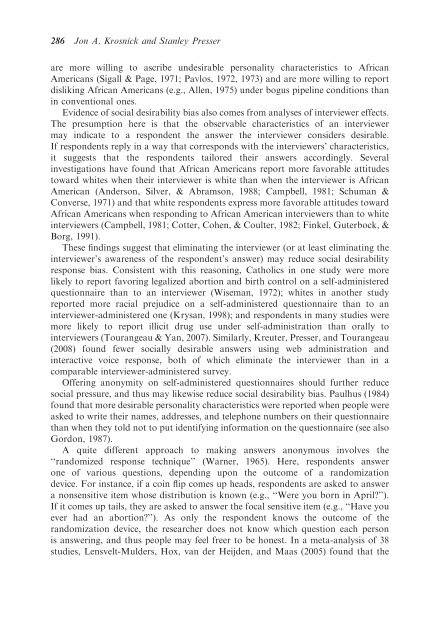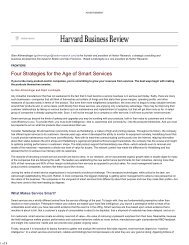Question and Questionnaire Design - Stanford University
Question and Questionnaire Design - Stanford University
Question and Questionnaire Design - Stanford University
You also want an ePaper? Increase the reach of your titles
YUMPU automatically turns print PDFs into web optimized ePapers that Google loves.
286 Jon A. Krosnick <strong>and</strong> Stanley Presserare more willing to ascribe undesirable personality characteristics to AfricanAmericans (Sigall & Page, 1971; Pavlos, 1972, 1973) <strong>and</strong> are more willing to reportdisliking African Americans (e.g., Allen, 1975) under bogus pipeline conditions thanin conventional ones.Evidence of social desirability bias also comes from analyses of interviewer effects.The presumption here is that the observable characteristics of an interviewermay indicate to a respondent the answer the interviewer considers desirable.If respondents reply in a way that corresponds with the interviewers’ characteristics,it suggests that the respondents tailored their answers accordingly. Severalinvestigations have found that African Americans report more favorable attitudestoward whites when their interviewer is white than when the interviewer is AfricanAmerican (Anderson, Silver, & Abramson, 1988; Campbell, 1981; Schuman &Converse, 1971) <strong>and</strong> that white respondents express more favorable attitudes towardAfrican Americans when responding to African American interviewers than to whiteinterviewers (Campbell, 1981; Cotter, Cohen, & Coulter, 1982; Finkel, Guterbock, &Borg, 1991).These findings suggest that eliminating the interviewer (or at least eliminating theinterviewer’s awareness of the respondent’s answer) may reduce social desirabilityresponse bias. Consistent with this reasoning, Catholics in one study were morelikely to report favoring legalized abortion <strong>and</strong> birth control on a self-administeredquestionnaire than to an interviewer (Wiseman, 1972); whites in another studyreported more racial prejudice on a self-administered questionnaire than to aninterviewer-administered one (Krysan, 1998); <strong>and</strong> respondents in many studies weremore likely to report illicit drug use under self-administration than orally tointerviewers (Tourangeau & Yan, 2007). Similarly, Kreuter, Presser, <strong>and</strong> Tourangeau(2008) found fewer socially desirable answers using web administration <strong>and</strong>interactive voice response, both of which eliminate the interviewer than in acomparable interviewer-administered survey.Offering anonymity on self-administered questionnaires should further reducesocial pressure, <strong>and</strong> thus may likewise reduce social desirability bias. Paulhus (1984)found that more desirable personality characteristics were reported when people wereasked to write their names, addresses, <strong>and</strong> telephone numbers on their questionnairethan when they told not to put identifying information on the questionnaire (see alsoGordon, 1987).A quite different approach to making answers anonymous involves the‘‘r<strong>and</strong>omized response technique’’ (Warner, 1965). Here, respondents answerone of various questions, depending upon the outcome of a r<strong>and</strong>omizationdevice. For instance, if a coin flip comes up heads, respondents are asked to answera nonsensitive item whose distribution is known (e.g., ‘‘Were you born in April?’’).If it comes up tails, they are asked to answer the focal sensitive item (e.g., ‘‘Have youever had an abortion?’’). As only the respondent knows the outcome of ther<strong>and</strong>omization device, the researcher does not know which question each personis answering, <strong>and</strong> thus people may feel freer to be honest. In a meta-analysis of 38studies, Lensvelt-Mulders, Hox, van der Heijden, <strong>and</strong> Maas (2005) found that the
















